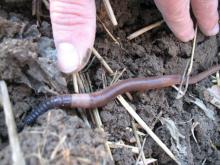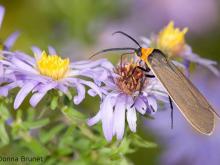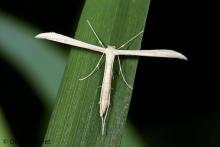Land Invertebrates
Media

Species Types
Scientific Name
Megarhyssa atrata
Description
The female black giant ichneumon wasp deposits her eggs through wood. The larvae eat the grubs of wood-boring insects.
Media

Species Types
Scientific Name
Megarhyssa macrurus
Description
The female long-tailed giant ichneumon wasp deposits her eggs through wood. The larvae eat the grubs of the pigeon tremex, a wood-boring horntail wasp.
Media

Species Types
Scientific Name
Lucanus elaphus
Description
The giant stag beetle is enormous, the males reaching 1½ inches in length without the mandibles, and nearly 2½ with them. Look for them on rotting logs in forests in early summer. They’re also attracted to lights.
Media

Species Types
Scientific Name
Epitheca spp.
Description
Female baskettails have a specially adapted, upturned abdomen tip, which allows them to carry around their egg masses in a little, orangish glob.
Media

Species Types
Scientific Name
Phanogomphus graslinellus
Description
The pronghorn clubtail is one of several members of its genus in our area that are generally difficult to identify. Like other dragonflies, it is an aerial predator that hunts insects on the wing.
Media

Species Types
Scientific Name
Plathemis lydia
Description
The common whitetail is a widespread species found across much of North America. Males and females look quite a bit different.
Media

Species Types
Scientific Name
Scudderia furcata
Description
The fork-tailed bush katydid reaches about 1¾ inches long. It is usually leafy green and is most common in bushes, thickets, and other shrubby areas. It is most active after dusk. The call is a simple "tsip!" given every few seconds.
Media

Species Types
Scientific Name
Melanoplus punctulatus
Description
The pine tree spur-throat grasshopper usually lives in wooded areas, where its mottled, brownish-gray camouflage protects it when it rests on tree trunks.
Media

Species Types
Scientific Name
Amynthas and Metaphire spp.
Description
Jumping worms are invasive earthworms that are native to east Asia. They are spreading in North America and cause problems for plants and soils. They thrash violently when disturbed.
Media

Species Types
Scientific Name
About 175 species in North America
Description
Earthworms are familiar to just about everyone who digs in the soil. They play a major role in the nutrient cycling and structure of soils. There are many species. The most familiar ones in Missouri are nonnative.
See Also



Media

Species Types
Scientific Name
Cisseps fulvicollis
Description
The yellow-collared scape moth is more often “orange-collared.” And whether you think it looks more like a firefly or a wasp, it’s still a moth!
Media

Species Types
Scientific Name
Nearly 150 species in North America north of Mexico
Description
Slim, delicate plume moths are instantly recognizable by their T-shaped silhouette, long legs, and muted shades of tan and brown. It can be hard to separate the various species.
Media

Species Types
Scientific Name
Pyrrharctia isabella
Description
Not many people know the adult Isabella tiger moth when they see one, but we’re all acquainted with its caterpillar, the woolly worm, or woolly bear.
About Land Invertebrates in Missouri
Invertebrates are animals without backbones, including earthworms, slugs, snails, and arthropods. Arthropods—invertebrates with “jointed legs” — are a group of invertebrates that includes crayfish, shrimp, millipedes, centipedes, mites, spiders, and insects. There may be as many as 10 million species of insects alive on earth today, and they probably constitute more than 90 percent all animal species.





















